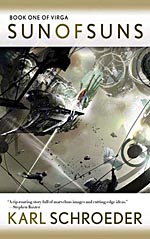
![]() Mattastrophic
Mattastrophic
6/17/2011
![]()
Sun of Suns uses a unique setting for a compelling story. I became invested in the major characters, and even those we are predisposed to dislike in the beginning become sympathetic and intriguing. No major character seemed to fall easily into a flat, clichéd role, which is something to treasure in SF. It begins with a revenge story: Hayden Griffin, the protagonist, has finally positioned himself within striking distance of the admiral who led the attack on his nation that cost his parents their lives. Hayden's burning desire for revenge becomes complicated as the plot progresses and his initial feelings are muddied by circumstance. I felt that his character progression was believable, although Schroeder seemed to favor telling over showing when it came to some of the pivotal moments of Hayden's inner struggle, which led to the use of some clunky exposition to get the job done. Since it's a pretty brisk novel, I ascribed this as a sacrifice to pacing. The pacing of the book was pretty good overall, with little to no drag throughout. Overall, Sun of Suns is a treat as far as imagery is concerned. Once you wrap your head around the basic concept of Virga you are able to enjoy the highly imaginative and playful things Shcroeder is able to set loose inside its bounds: cities built inside free-floating bodies of water the size of oceans, buildings and towns in free-fall linked by intricate series of guide ropes, gigantic bugs, and a myriad of colorful clouds that can hide dangers for the floating traveler like unseen rocks and enemy ships. The action is a treat to imagine as well: battles between wood-and-steel battle ships and air-bikes in a zero-g environment of seemingly endless sky and cloud. It makes for some striking imagery. Ships fighting in free-fall don't have to meet each other on the same planes/axes, and that may have been something Schroeder could have played with more but other than that I thought the action was satisfying and the settings highly imaginative. While there is a lot of great play of the possibilities within Virga, there is not terribly deep. There is an interesting moral contemplation of revenge bundled in with Hayden's development, but the short scenes in which we are invited to truly ponder the purpose for a world like Virga are few and far between. Perhaps this is something that will be dealt with in further novels (or so I hope). Still, it's a fun ride with compelling characters through a highly imaginative world that really forced you to slip out of your gravity-bound mindset in order to play along. Based on its length, pacing, and it's lack of deep, technical scientific explanations, (and despite some of its mature content) I wonder if this book was intended for a YA audience, although it has something for all readers and can be enjoyed by just about any fan of SF. In terms of creating and using mega-structures in a work of SF, I found Schroeder's contribution to be superior to some other books involving mega-structures like Niven's Ringworld because it was used as a backdrop for a good story, and not just as something to gawk at I'll definitely be on the lookout for a copy of Queen of Candesce, the second book in the Virga series.
http://www.strangetelemetry.wordpress.com